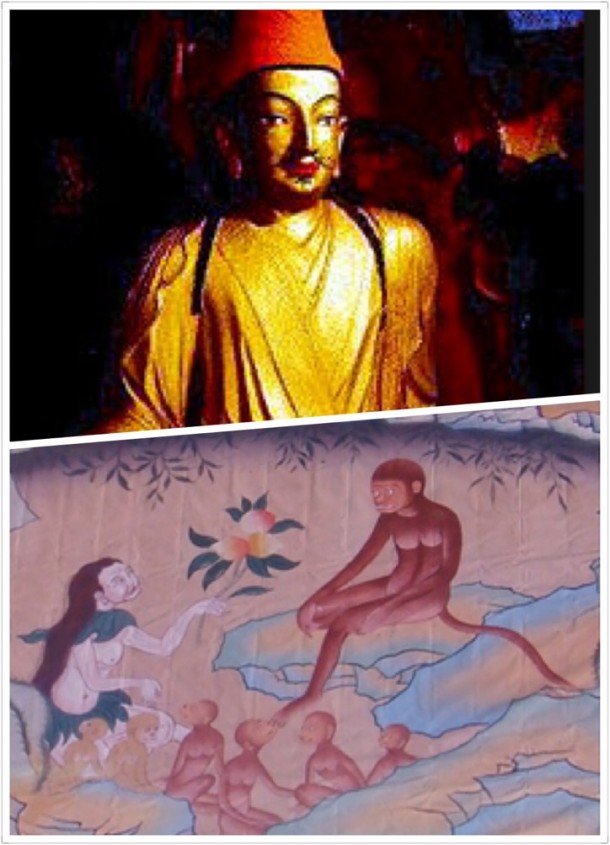Pha Trelgen Changchup Sempa And Great Empire The Songtsen Gampo Of Tibet.

Every nation has its own history of their existing or civilizing then and Tibet is not different from the rest of the world.The beginning of Tibet is very much different from the other myth of any other nation and we must say its a mesmerizing and was very mind blowing.This is a very different nation with very compassionate and selfless. A very popular Tibetan creation myth holds that in the beginning the world was covered by water, which evaporated little by little, leaving room for animal life. To the flooded land of Tibet came a monkey that had withdrawn there to immerse himself in meditation and to follow a life of asceticism and chastity. He settled on mount Gongori. One day, while he sat in meditation, a female demon came to seduce him. Tradition has it that she was the manifestation of the bodhisattva Tara (Jetsun Dolma in Tibetan), a symbol of compassion and protector of merchants and travelers. She threatened that if he refused to sleep with her she would visit a demon and conceive a multitude of small monsters that would destroy all living creatures. The wise monkey yielded and requested Avalokitesvara’s authorization to marry her. Avalokiteśvara blessed the monkey and the female demon, and a few months later six small monkeys were born of their union. The monkey let his six children grow up in the forest, but three years later he discovered that they had become five hundred. The fruits of the forest were no longer sufficient to feed them, and the five hundred monkeys beseeched their father to help them find food. Not knowing what to do, he went again to ask help from the god of compassion. Then Avalokiteśvara went on the mount Meru, or sumeru (believed to correspond to today’s Mount Kailash), a sacred place for Buddhists, Hindus,Jains and Bonpo. Some say that at the top of the mountain he gathered a handful of barley, others that he extracted five cereals from his own body to offer to the monkey father. Then the monkey father learned agriculture and, after a good harvest, could finally feed all his children. As they fed on the cereals, the monkeys gradually lost their hair and their tails. They also started to use bone and stone implements, then made clothes and built houses, forming a civilization from which the Tibetan people descended.As this species lived on and gradually penetrating king’s system and One of the most renowned and popular was The Songtsen Gampo. He was born in 617 C.E. and ascended the throne at the age of thirteen. He ruled for twenty years during which time he established the orders of the powerful empire that extended far beyond the immediate area of the Yarlung Valley. Tibetan forces were active from the plains of northern India to the Chinese frontiers in the east and the borders of the Turkish empire in the west. songtsen Gampo established a summer capital in Lhasa and built a palace), As a gesture of friendship towards their threatening neighbor, Nepal and China each offered the king a bride from their royal families. In the broadening his horizons, the king became aware of the Buddhist civilization prevailing not only in its country of origin, India, but also as the spiritual inspiration of the newly formed T’ang dynasty of China. The prestige and significance of Buddhism was further impressed upon him by his Nepalese and Chinese wives and the dowries they brought with them containing magnificent status of the Buddha. Whether this warring man actually became the devout Buddhist king that popular tradition makes him out to be is open to question. But it is certain that he encouraged the building of temple to house the images brought by his wives and was probably responsible for the construction of several other religious shrines throughout the land. He also sent his minister Tonmi Sambhota to India to create a written script suitable for the transcription of Tibetan. This enabled the Tibetan to start translating the Sanskrit Buddhist scriptures into their own Language. The current language script that we are using now a days were introduced by this great king of Tibet.
Recent Posts
Exploring Mount Kailash in Tibet
Embarking on a Spiritual Quest in Tibet
Exploring the Beauty of Tibet in Spring
All Categories
- About Tibet
- book a Tibet tour
- Buddhism Practice
- Budget Tour
- China-Tibet Train
- Customized Tibet tour
- Historical Sites
- Hot Springs in Tibet
- News
- Photography in Tibet
- Tibet attraction
- Tibet Group Visa
- Tibet Motorcycle Tour
- Tibet Small Group Tours
- Tibet Tours and Tibetan Tour Guide
- Tibet Train
- Tibet Travel FAQs
- Tibet Travel Information
- Tibet Travel News
- Tibet Travel Permit Update
- Tibet Travel Prices Rises
- Tibet Trek
- Tibet Trekking Tour
- Tibet weather and climate
- Tibet Wildlife animals
- Tibet Winter Tour
- Tibetan Buddhism
- Tibetan Cultural Features
- Tibetan Culture and Poeple
- Tibetan Festivals
- What to see in Tibet



